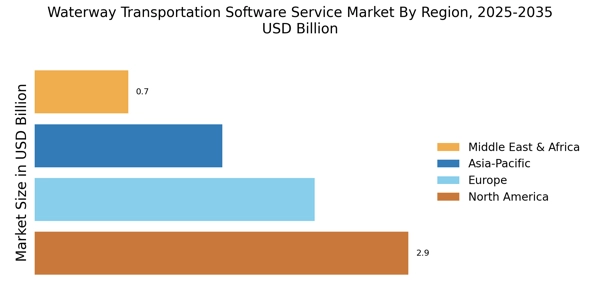Government Initiatives and Investments
Government initiatives aimed at enhancing infrastructure and promoting waterway transportation are significantly influencing the Waterway Transportation Software Service Market. Various countries are investing in port modernization and the development of inland waterways to facilitate trade. For instance, recent reports indicate that investments in waterway infrastructure are expected to exceed $10 billion in the next decade. These initiatives not only improve the physical infrastructure but also create a favorable environment for software solutions that can manage and optimize these assets. As governments prioritize sustainable transportation methods, the demand for software services that align with these initiatives is likely to increase, presenting opportunities for growth within the market.
Growing E-commerce and Consumer Expectations
The Waterway Transportation Software Service Market is significantly influenced by the growth of e-commerce and evolving consumer expectations. As online shopping continues to expand, the demand for efficient and reliable transportation solutions becomes critical. Consumers now expect faster delivery times and real-time tracking of their orders, which places pressure on logistics providers to enhance their operations. Recent data indicates that e-commerce logistics is projected to grow at a rate of 7% annually. This trend suggests that software services that facilitate seamless integration between e-commerce platforms and waterway transportation systems will be in high demand, as businesses strive to meet consumer expectations while optimizing their logistics processes.
Increased Focus on Environmental Regulations
The Waterway Transportation Software Service Market is increasingly shaped by stringent environmental regulations. As nations implement policies aimed at reducing carbon emissions and promoting sustainable practices, the demand for software solutions that ensure compliance is rising. Companies are now required to monitor their environmental impact closely, which necessitates the use of advanced software tools. Recent statistics suggest that the market for environmental compliance software is expected to grow by 6% annually. This trend indicates that waterway transportation software services that incorporate features for emissions tracking and reporting will likely gain traction, as businesses strive to meet regulatory requirements while maintaining operational efficiency.
Technological Advancements in Data Analytics
Technological advancements in data analytics are transforming the Waterway Transportation Software Service Market. The integration of big data and machine learning into transportation software allows for enhanced decision-making and predictive analytics. Companies can now analyze vast amounts of data to optimize routes, reduce costs, and improve service delivery. Recent studies show that organizations utilizing data analytics in their logistics operations can achieve cost reductions of up to 15%. This capability not only enhances operational efficiency but also provides a competitive edge in the market. As more companies recognize the value of data-driven insights, the demand for sophisticated software solutions that leverage these technologies is expected to grow.
Rising Demand for Efficient Logistics Solutions
The Waterway Transportation Software Service Market is experiencing a surge in demand for efficient logistics solutions. As businesses seek to optimize their supply chains, the need for software that enhances operational efficiency becomes paramount. This demand is driven by the increasing complexity of global trade and the necessity for timely deliveries. According to recent data, the logistics sector is projected to grow at a compound annual growth rate of 4.5% over the next five years. Consequently, software services that streamline waterway transportation processes are likely to see heightened adoption, as they offer tools for route optimization, cargo tracking, and inventory management. This trend indicates a robust market potential for software providers who can deliver innovative solutions tailored to the unique challenges of waterway logistics.


















Leave a Comment